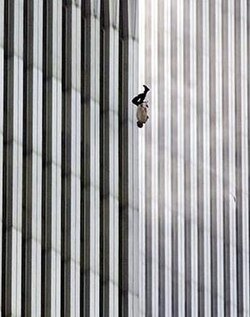The Falling Man

The Falling Man is a photograph by Richard Drew depicting a man who had jumped from the World Trade Center during the September 11, 2001 terrorist attacks in New York City. The subject is one of the trapped people (dubbed "jumpers" by the press) who jumped from the upper floors of the World Trade Center to certain death.
The powerful and controversial photograph provoked feelings of anger, particularly in the United States in the immediate aftermath of the September 11 attacks. The photo ran only once in many American newspapers because they received critical and angry letters from readers who felt the photo was exploitative, voyeuristic and an invasion of the faller's privacy. This lead to the media's self censorship of the photograph, preferring instead to print photos of acts of heroism and sacrifice. Though offensive to some, it has become a symbol of the terror of the September 11th attacks to others.
Drew argues that the photograph does not depict the death of the subject, but his life. The man is still alive, and the picture captures the last moments of that man's life. Drew said "there is no blood, no guts, no gore. He is still alive, he is not dead". {{citation}}: Empty citation (help)
On March 16 2006, a British television station Channel 4 ran 9/11: The Falling Man, a documentary on the picture (and the story behind it). According to the programme, the man in the photograph is believed to be Jonathan Briley, a sound engineer who worked at Windows on the World, the restaurant at the top of the North Tower.
References
- Junod, Tom (September 2003). "The Falling Man". Esquire. [1]
- 9/11: The Falling Man (March 16 2006). Channel 4.
